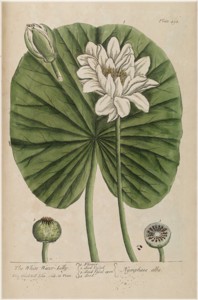Languorous Waterlily
By Audrey Stallsmith

The lotus; of which fruit what man soe'er
Once tasted, no desire felt he to come
With tidings back, or seek his country more,
But rather wish'd to feed on lotus still
"The Odyssey of Homer"-William Cowper
"From the pool," Louise Beebe Wilder writes in The Fragrant Path, "water lilies seem to be the very breath of summer." Those floating flowers, which frequently close in the afternoon, have long been associated with the sweet languor that tempts a person to dream away a lazy summer day.
But Homer's Odyssey and a later poem by Tennyson portray some lotus-eaters, supposedly occupying the North African island of Jerba near Tunis, who wanted to dream away their entire lives! It seems likely, though, that the Tunisian "lotus" was not the aquatic plant but jujube, Zizyphus jujuba, which was also known as lotus tree.
Although some ancient peoples did make bread from water lily seeds, jujube produces fruits-called Chinese dates--that would be much easier to eat! And its seeds are narcotic, which might explain the lotus-eaters lethargy.
On the other hand, the Egyptian blue lotus, Nymphaea caerulea (AKA Nymphaea stellata or nouchallii), can reportedly be narcotic too-when soaked in wine. The ancient Egyptians seem to have combined the flower with opium poppy and mandrake to induce visions. And an extract of Persian lotus, Nelumbo nucifera, may have substituted for opium in some World War I operating rooms.
Since the Egyptian blue lotus belongs to the nymphaea rather than the nelumbo family, it technically isn't a lotus at all, but a water lily. Water lilies sport pointy petals, while the petals on lotuses round themselves off.
The "nymph" in the former's name probably refers to Lotis, the mythological daughter of the water god, Neptune. Legend holds that she turned into a water lily while fleeing from Priapus, the ugly but ever lascivious god of fertility. (Unless, of course, it was the lotus tree into which she metamorphosed. But, considering her paternity, the water lily sounds more appropriate!)
The blue "lotus" was so respected that it came to symbolize lower Egypt. (Papyrus represented the upper part of the nation.) When Egyptian VIP's died, their bodies were frequently laid out with an intricate covering of Nymphaea caerulea petals.
The true lotus or nelumbo was also revered by ancient cultures like China and India, perhaps because, as Wilder writes, it "has its roots in the mud but its fragrance reaches the throne of God." Buddha supposedly landed on a lotus after his creation and sleeps on one half the year. According to Mohammed, founder of Islam, the flower also grows in seventh heaven
Water lilies and lotuses generally inhabit shallow water, their rhizomes anchoring them to the muck while their round leaves bob on or are held above the surface. The flowers of hardy water lilies usually float comfortably too, while the blooms of tropical types and lotuses hold their heads high. This prideful attitude may be due to the fact that tropicals tend to be larger, more fragrant, and available in a wider range of colors. While most hardy varieties and lotuses open during the day, some of the tropical water lilies strut their stuff at night.
Wilder describes one of the most spectacular, Victoria Regia-which originated in South America, as having leaves "often seven feet or more in diameter " and "great blossoms, measuring from eight to fifteen inches across. They partly close with the coming of light but open again the following night, the petals changing the while from gleaming white until by the third day they have become a deep purplish red. The fragrance of these great flowers is rich and pervading, strongly fruity, like Pineapple. . ." Those ones might almost be big enough for someone to sleep on!
Because it is an example of unspoiled beauty springing from mud, the water lily stands, in the Language of Flowers, for "purity of heart." The lotus, perhaps due to its speaking scent represents "eloquence." Although the plants are not frequently employed as a medicine these days, poultices made from the leaves and rhizomes of Nymphaea odorata (white pond lily) and Nuphar advena (yellow pond lily or spatterdock) once soothed boils, tumors, ulcers, and other inflammations.
Perhaps another reason the water lilies are associated with sleep is because the fragrance of the night-bloomers tends to be the most intense. Wilder reports that "Brought into the house the delicate but exquisite sweetness, not unlike that of a Magnolia but with a faintly bitter tang, finds its way through the darkness to all the rooms. . ."
Let's not forget that faintly bitter tang! Although we all need an occasional vacation from reality, it is possible to become so addicted to dreams that we never seek their fulfillment. Like the sailors in the Odyssey, we can be all too easily deflected from our quests by the deadly sin of sloth. The Lotos-eaters of Tennyson's poem ended up pleading for "long rest or death, dark death, or dreamful ease." Perhaps Lotis got her revenge, after all!
Note: Nymphaea alba image is from A Curious Herbal by Elizabeth Blackwell, courtesy of the Missouri Botanical Library.








